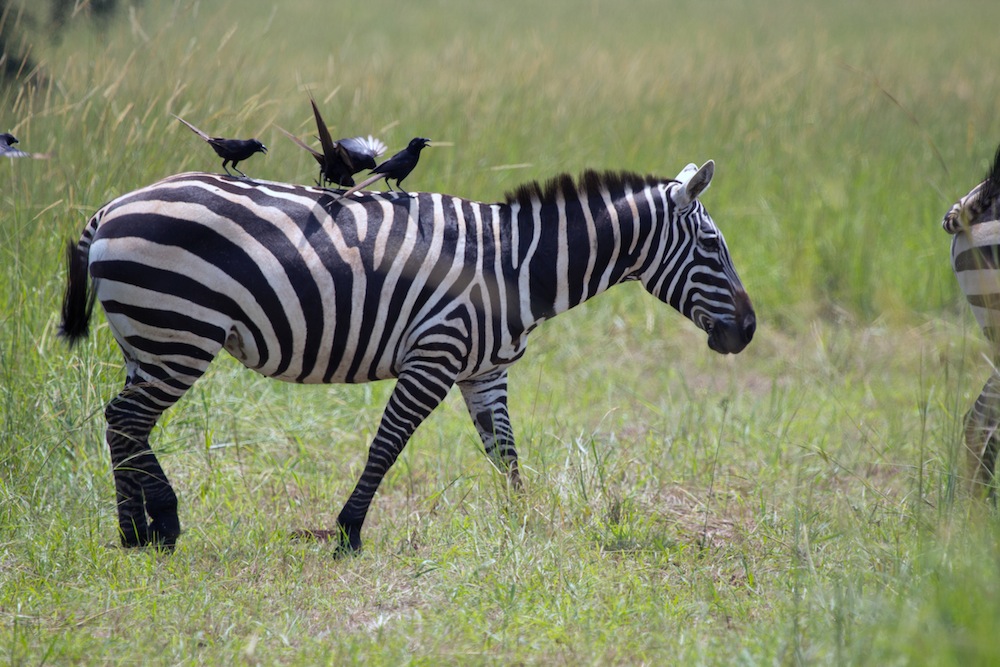Why Do Zebras Have Stripes? It's Not for Camouflage

Zebras' thick, black stripes may have evolved to help these iconic creatures stay cool in the midday African heat, a new study suggests.
Many African animals sport some stripes on their bodies, but none of these patterns contrast as starkly as the zebra's. Researchers have long struggled to explain the purpose of the zebra's unique black-and-white coat. Some have suggested that the stripes may help zebras camouflage themselves and escape from lions and other predators; avoid nasty bites from disease-carrying flies; or control body heat by generating small-scale breezes over the zebra's body when light and dark stripes heat up at different rates.
Still, few scientists have tested these explanations, and many argue that the stripes serve a complex mix of purposes. [See images of plains zebras across southern Africa]
Now, researchers based at the University of California, Los Angeles (UCLA) have produced one of the most comprehensive zebra stripe studies yet by examining how 29 different environmental variables influence the stripe styles of plains zebras at 16 different sites from south to central Africa.
The scientists found that the definition of stripes along a zebra's back most closely correlated with temperature and precipitation in a zebra's environment, and did not correlate with the prevalence of lions or tsetse flies in the region. These findings suggest that torso stripes may do more to help zebras regulate their body temperature than to avoid predators and tsetse flies, the team reported Tuesday (Jan. 13) in the journal Royal Society Open Science.
"This wall we kept hitting up against was, 'Well, why do zebra have to have stripes for predation? Other animals have predators, and they don't have stripes,'" said study co-author Ren Larison, a researcher in the Department of Ecology and Evolutionary Biology at UCLA. "And other animals get bitten by flies, and they don't have stripes, either."
Other animals also need to regulate body temperature, or thermoregulate, Larison pointed out, but zebras may especially benefit from an extra cooling system because they digest food much less efficiently than other grazers in Africa. As such, zebras need to spend longer periods of time out in the heat of the midday sun, eating more food.
Sign up for the Live Science daily newsletter now
Get the world’s most fascinating discoveries delivered straight to your inbox.
"Zebra have a need to keep foraging throughout the day, which keeps them out in the open more of the time than other animals," Larison told Live Science. "An additional cooling mechanism could be very useful under these circumstances."
The team found that the plains zebras with the most-defined torso stripes generally lived in the Northern, equatorial region of their range, whereas those with less-defined torso stripes were more common in the Southern, cooler regions of the range — a finding that supports the thermoregulation explanation.
Still, the researchers have not experimentally tested the theory that black and white stripes may generate small-scale breezes over a zebra's body, and some researchers don't think stripes can actually create this effect.
"I don't think that you would want to have a lot of black hairs along the top of your back if you wanted to try to keep cool," said Tim Caro, a professor of wildlife biology at the University of California, Davis, who studies zebra stripes but was not involved in the new study. "It's kind of the last color that you would want."
Caro said regions with warmer, wetter climates are particularly susceptible to several species of disease-carrying flies other than the tsetse fliesthat the team considered in their study, and that the relationship the researchers found may actually be a function of fly avoidance, not thermoregulation. Flies seem to struggle to recognize striped surfaces, but scientists have not quite figured out why this is, Caro told Live Science.
The study co-authors emphasized that their findings require follow-up research, and that a zebra's stripes likely serve multiple purposes. For example, stripes on a zebra's back may help thermoregulate, whereas stripes on the animal's legs — where zebras are more likely to get bitten by flies — may help them avoid disease-carrying flies other than tsetses, Larison said.
"Really, the striping is kind of extraordinary, so you need something extraordinary to explain it," Larison said.
The researchers plan to test their thermoregulation hypothesis, either by studying the behavior of air currents over zebra pelts, or by implanting wild zebras with temperature sensors, if they are granted permission to do so, Larison said.
Follow Laura Poppick on Twitter. Follow us @livescience, Facebook & Google+. Original article on Live Science.










